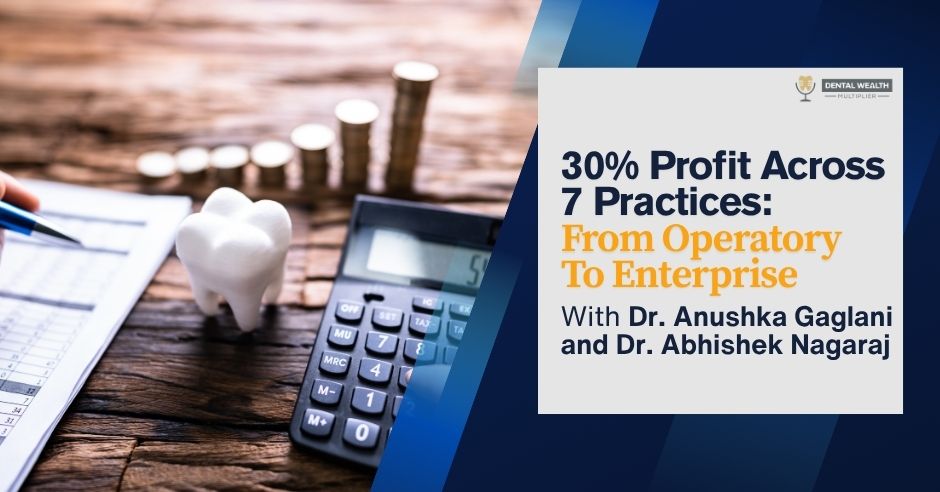
Jonathan Moffat is joined by Austin Moffat, Dr. Eric Roman, and the founders of Areo Dental, Dr. Anushka Gaglani and Dr. Abhishek Nagaraj, for an open and honest conversation about what it really takes to scale a multi-location dental group. They share the early challenges they went through, the leadership and financial frameworks that kept them aligned, and how they built a seven-location organization without losing margin, clarity, or purpose. This is a real look at profitable growth, smart decision-making, and the human side of running a dental business.
Learn more about Areo Dental at areodental.com
Find Jonathan at jonathanmoffat.com
Learn more about Aligned Advisors at alignedadvisors.com
Connect with Austin and the team at dsocfo.com
New episodes drop every week with real strategies for building a practice and a life that work together. Visit dentalwealthmultiplier.com for more!
—
Watch the episode here
Listen to the podcast here
30% Profit Across 7 Practices: From Operatory To Enterprise With Dr. Anushka Gaglani and Dr. Abhishek Nagaraj Of Areo Dental
Dr. Anushka Gaglani & Dr. Abhishek Nagaraj Of Areo Dental
We have some special guests with us, Dr. Gaglani and Dr. Nagaraj. We also have joining us Austin Moffat, with DSO CFO. We’re going to get into some really cool stuff. I’m really excited. Thank you both for joining us and being here to share your journey and what some of the keys to help you be successful to growing your group practice. Starting off, tell us a little bit about maybe how you guys met, how you linked up and how you started your first practice together.
We actually met when we were teenagers. I actually grew up in India and I did a study abroad there, and that’s where we met. We both went to dental school. He went to NYU. I went to school here in Chicago. I associated for about 3 or 4 years and got really tired of it and I was like, “It’s time to do something else.” We started our own practice together. At the end of 2015, it was the acquisition of an older dentist practice. It was dying. He should have probably sold it a few years before. We renovated the whole thing and that’s where it took off. A few months later, we got tired of looking at each other, so we decided to open a second practice. It just went from there.
A few months later? All right.
Six months later, actually.
How many locations do you guys have now?
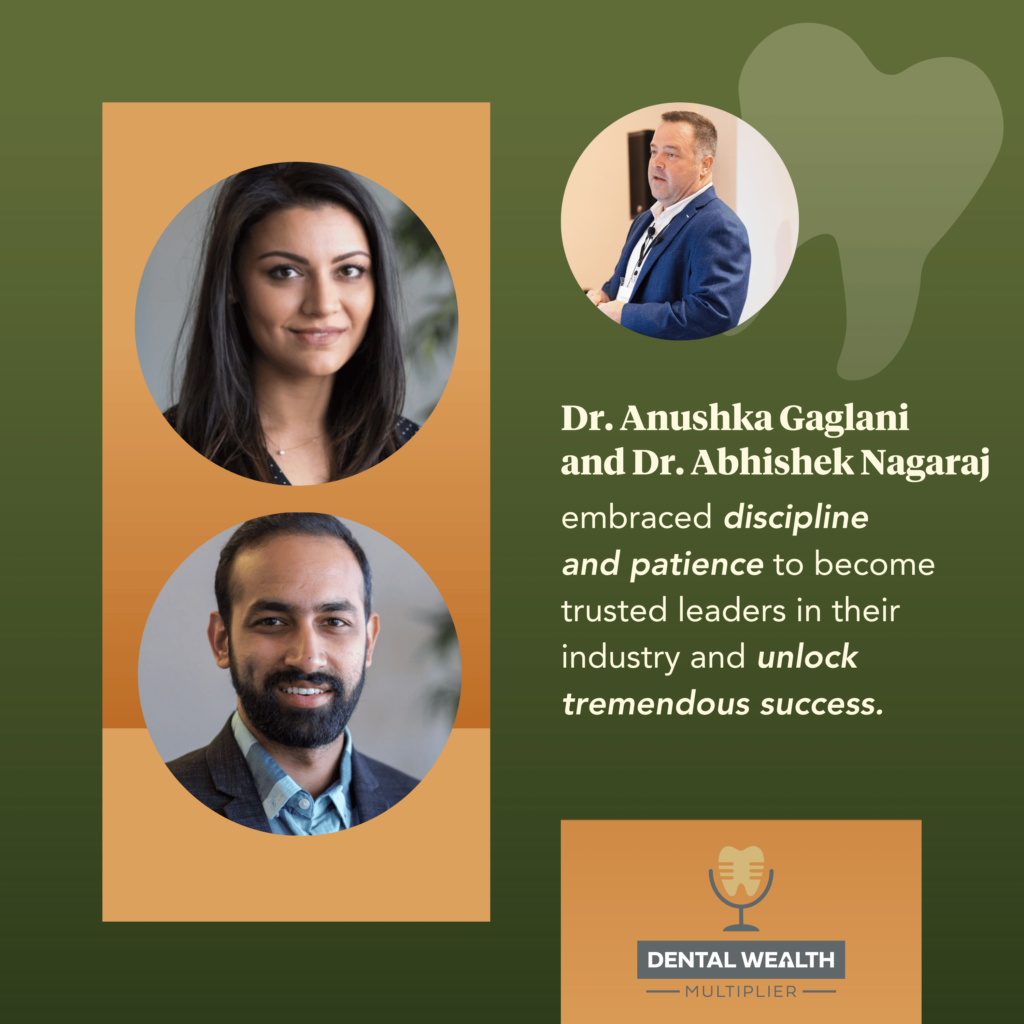
We have seven.
Valuable Lessons From Their Career
What have been some of the lessons learned along the way? In other words, if there’s someone reading this, that’s maybe at practice number 1, or maybe they’re practice number 5 and they’re struggling, what have been some of those lessons that you guys have learned that you’re like, “If I could go back to 2015 or ‘16 and tell myself back then, ‘These are some lessons that we learned?’”
Lots of lessons. I think in our first lesson, we always bought underperforming practices. Our thought was if you buy an underperforming practice, our downside is a lot lower than buying a million-dollar practice and not knowing what to do with it. We clearly did not know what to do when we bought our first practice. When we bought our first practice, we bought a $200,000 in revenue practice that we eventually ramped up to about $1.8 million in about two years. We were also the dentist in the chair, updating technology and just educating patients. That was one way to do that.
I think we recognized pretty quickly that costs escalate way quicker than revenue scan. Revenue is the hard part. The second lesson we learned along the way was that we started reading some leadership-type books, and we realized that revenue is vanity, profit is sanity, but cash is king and queen. Just having cashflow in the bank really strengthens you and makes you feel really good about where you are. You can actually go take some risks. At least at a high level, those are the two learns that I’ve had. Anything you want to add to that?
I think those are great points. For me, I’d probably add belief in yourself a little bit earlier. There was always this fear around, “We have this practice and we have to be dentists, and this is what we went to school for.” It’s pulling back a little bit sooner is probably what I would’ve done differently, rather than forcing myself to practice for as long as I did.
Is that still the strategy that you guys use now or has your strategy changed as you’ve continued to grow, buying practices that are of lower value and improving them?
I think we’re open. Obviously, we can’t be in the chair and ramp these practices up to $1.8 million to $2 million. Dr. Eric, you know that really well being a dentist. We’ve been transitioning out of that. We don’t buy practices that are probably doing $200,000 or $300,000, unless it’s an amazing opportunity that we just don’t want to pass upon, has some real estate involved, then we’ll still do it. We feel confident that we can take on an associate and ramp them up.
The strategy has changed in terms of if we’re going to do that, we probably can start up a practice, do a de novo for $400,000 to $500,000, and then ramp them up, and have larger capacity in those practices. That’s probably how our thought process has changed or let’s buy some existing cashflow type business, which is $800,000 in revenue, which has maybe $150,000 in margins. Now we can really optimize that, take that to like $500,000 in margins. There’s so much low-hanging fruit in those types of practices. That’s probably how it’s changed.
Where do you guys spend the majority of your time now? I know you mentioned that you wish you had believed in yourself sooner and gotten out of the chair sooner. I’m assuming that’s what you’re referring to. Where do you spend most of your time now in the group?
We each practice a day, a week. We run on EOS, Entrepreneur Operating System. We’ve flip-flopped a bit. I started off as visionary and Abhishek was the integrator, and now we switched. He does the visiony stuff. He does M&A. He like talks to potential dentists, etc.
At least I try.
He does a very good job. He’s selling himself short. I am apparently a process person, I found out, so I’m big on the processes. As the Clinical Director, I make sure you know that the revenues are keeping up, the dentists are doing what they’re supposed to do.
Determining The Right Skills To Success
I just want to acknowledge what you’re both saying. Your roles in the business have changed, but also how you interact with each other, what I also heard you say, Anushka, was recognizing skills that you had that might not have been so apparent earlier in the journey. Do you feel like this is a common experience? Is this something you hear other people talking about?
In terms of like they don’t know what their skills are, I think so. I think it takes time. When I said that belief in wanting to get out of the chair sooner, despite saying that I still don’t regret it because I think it took that time to figure out where my skills were. One of the other things we did, I think it took a personality test for us to figure it out because it was the two of us for a long time. We ran everything before we added a VP of ops. Somehow, things would just magically get done and we’re like, “We’re a great team. We just get stuff done.” We realize it’s because of the personality test, we have very complementary skills, which is cool. It worked out really well.
In hindsight, I don’t regret that we were in the chair because we were able to personally check off the clinician box with the clinicians who do $2 million a year, as we know what that feels like and can actually really resonate. It resonates and relates. We can relate to our associate dentists where we hire, they’re doing $700,000 or $600,000 a year, and they’re like, “How do you do go to $1.5 million or $2 million?” “We’ll show you how to do it.” That’s a really cool feeling.
We probably started to feel some burnout along the way, I think, as most dentists do 6, 7 years in. We were able to build a nice nest egg, too, in the process, which gave us the courage and the commitment to say, “We don’t need to sit and maybe make dentures for patients for the rest of our lives. We can actually go teach other dentists to be able to do that.”
How’d you deal with the burnout? I heard that and I hear it so much. What did you do when that hit?
Yeah, the ceiling of complexity. I think the first thing we did was it probably took some time off. The best thing we ever did was, in 2022, we took three weeks out. There was probably at the peak of our burnout. We were 5 days in the chair with 5 practices. We’d actually just parted ways with the previous director of ops for multiple different reasons. We probably don’t want to get into that. We were running everything. The doctor payroll to the operations. We hadn’t finalized our next director of ops for six months. It was brutal. We said, “Screw it. Let’s just go to Antarctica for three weeks and see what breaks in the business.” That’s how we dealt with that, Eric.
We run away from it.
We came back and nothing broke. The business wasn’t multiplying, but I can’t even say it was self-managing. Two of the practices were closed where we were practicing, but the three practices did okay. That’s when we recognized it was that turning point when we said, “We can actually step away and create systems in the business.” We went on a quest to become better as leaders.
That was the last time we said, “Never again are we going to take time off and have a practice close.
I know that any people reading are probably wondering, too, what personality test did you guys take that helped you identify those strengths? Do you remember?
We’ve taken a lot, but the one that really tied it together for us was the Kolbe, but also the Culture Index, Predictive Index. The Culture Index is like a spinoff of the Predictive Index. Those have been great as well.
It just helped us recognize what our strengths are. Initially, we’ve always gravitated towards opposite things, different things, so we’re complementary. We’ve always been the yin to the yang, but we’d never recognized that the skills that you don’t have that I have, or vice versa. We understood when we started taking these tests to be like, “Maybe we should just really focus on these and it’s actually not a bad thing to not have some of those other skills.”
Maintaining Profitability In Seven Locations
I think something that is very impressive, it’s something that is I think a lot of people reading would want to know how to do it, is while growing your group, you’ve managed to maintain this very impressive profitability. Are we okay to talk about what that looks like? What’s your profit that you guys are typically running as a group in terms of percentage-wise as a group of seven locations?
Austin’s here. He can tell you better than we can. I think from what we saw last time, what we learned, we were at about 31% as a group.
That’s amazing. It’s unheard of.
We aim 30% at the practice level, to be honest. I think every practice needs to do 30% to 35%. Anything less is less for us. It feels like we’ve done a lot of the work for very little margins. I think we’re conscious about our costs quite a bit. We look at every month how to cut costs as opposed to how to add, and instead of adding, how do we add revenue. That’s cool too. That’s great but you can’t always cut costs the same way, so that’s what we aim for.
Always look for ways to cut costs instead of adding just to increase revenue. Share on XTo be fair, you guys float pretty consistently between 30% and 35%. I would say you guys really are floating more so around 33% trailing 12 months, which is so unique. I’ll jump in with my own question. I’ll just be super open. We come into our meetings and you’ve heard me say this ten times by now, Dr. Nagaraj and Dr. Gaglani.
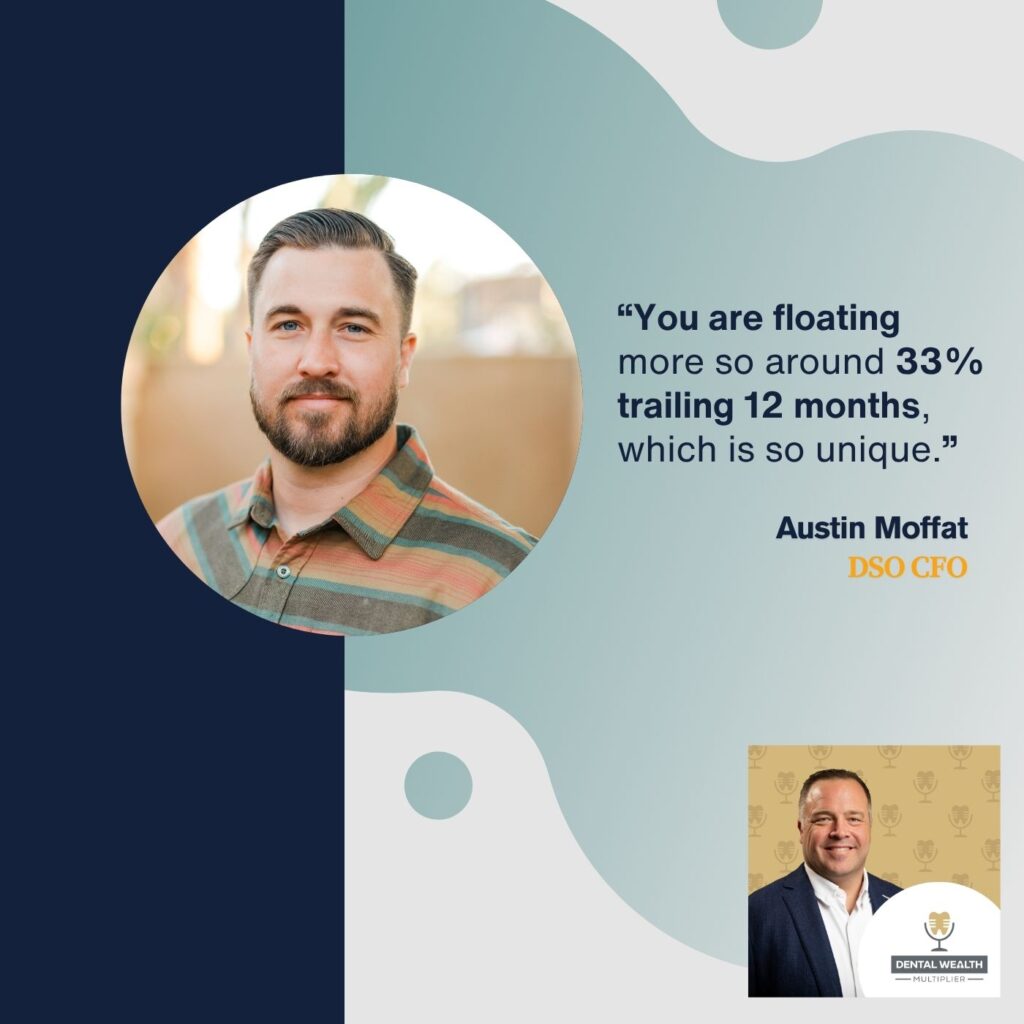
I actually come to our meetings to review your financials. I ask you what you guys are doing versus I would say 9 times out of 10, in my other meetings, we’re discussing budgetary strategy items, but it’s the opposite. If I may, what are you guys doing across the board that is keeping the profitability so high? Revenue, like you mentioned, is great. You also mentioned cost-cutting. What is that that you’re doing so consistently? I’ve seen you guys go get other practices and you’ve been able to mold those practices to your group already, which is pretty tough to do. I’ve seen many groups do it and it’s a lot easier said than done.
One really quick point, Austin, I think if you weren’t giving such clean P&Ls every single month, it probably would be hard for us to optimize the same way. I want to make sure we throw that credit back to you, definitely. You are doing a phenomenal job of keeping P&Ls really clean so it’s visible to us. That’s number one. I don’t know why every dentist is not hiring you.
I appreciate that.
Number two, I think we are conscientious. We look at costs super closely. We reconcile bank accounts personally every two weeks. It’s important that we do that. I think a lot of owners, somewhere along the way, forget that. They’re like, “It’s too busy.” We’re going through bank statements and credit card statements diligently. We probably catch at least $5,000 to $10,000 every month where someone screwed up. Someone overbilled you, the lab overcharged you. Just making sure we hit these. It does take a little amount of time, but it’s well worth it. That would be on the cost side.
I think it’s everything, even things like inventory, having budgets for everything. I’ve heard of too many practices where they’re used to just like, “Order whatever you want,” and that’s not how a real business works. Watching those expenses, I think, is key. I think the biggest expense, of course, is employees. We are not the practice that has 4 ops and has 7 people floating around, all doing 30% of their workload. We hire A players. If they’re not A players, there’s no room for them because we need everybody to be doing 100% of what they’re supposed to be.
I love that you said that. I think our revenue per employee is really good. I think we make sure we can give the right carrots to our employees where we can have 4 or 5 rock stars pay them like 8, but they’ll work like 10. That’s really the reality. Eight is good.
Just maximizing, making sure you have A players, making sure that you’re not overstaffed. How much time do you spend on training those A players and putting your systems and processes within the organization?
Are you asking how much time?
Yeah. If you go buy a practice, you’re identifying, “This is a practice we’re going to buy.” Let’s say it’s 6, 7 ops, they’ve got a team there. As you go into that practice, what are some of the first things that you’re looking at to say, “These are some of the changes we’re going to make to get them to fit more of what we’ve built here as a group?”
We were seeing in a practice. We met with the owner and I think we were pretty upfront saying everything will change, basically. We were upfront and that we are not the group that says, “Nothing will change,” and then make a bunch of changes because it just creates mistrust on the line. If they’re not okay with that, that’s okay. They can probably find another buyer for their practice.
Basically, software systems to analytics to everything that they don’t have, they will have and it’s actually for the betterment of the practice and the teams. More benefits will roll around. We can also reduce supply costs. Their comp will go up because those doctors are not so burned out anymore. They can reduce chair time, but actually make equal or more than what they were doing before. Those are some upfront conversations we’re having with them.
What I hear inside of that is what your recipe that you’ve discovered in a sense is to find, maybe we’ll call it good practices that don’t have good systems, that don’t have all the economies that you guys have. It’s really plug and play. If they’ve already done all that stuff, that might not be a fit. Is that where you guys have come to?
Yeah, I think you can say that. If they’ve done everything and they’re operating at 15%, 20% margins, there’s probably not a lot of lemonade to squeeze out of that. It’s probably the practice that has 15% margins, but has a lot of these, to your point, decent systems, but there’s so much they’re missing. They’re letting dentistry walk out the door. Their costs are all high. Their lab bills are super high, but they don’t care. Those are things that’ll change that instantly add another 6% to 7% to our bottom line.
Eric, do you have any other questions that you can think of off the top of your mind?
I got like a million.
This is good stuff.
Finding Success Outside Of Dental Practice
Tell me a bit a little bit about what the journey has been like for you guys as individuals, like personally outside of the practices because one of the things that we have in this pervasive world is that the world just sees the success of Areo Dental Group and we fail to discount how that translates to your personal lives. Has it, and what have been the challenges in that journey, having a successful business, but actually turning it into a successful life?
Outside of the business, I think you’re right. It’s just sometimes it feels a bit isolating. The truth is it’s isolating. You and I have talked about that. I think it was Alex Hormozi who said, it resonated so much with me, that when you start finding success in your business, you potentially start outgrowing some of your existing friends, but you haven’t found the new friends who are super successful. You’re in this middle journey that’s isolating. We felt that.
I think we’re coming out of that just be by finding tons of gratitude, taking some time off rejuvenating. We’re also part of EO, Entrepreneur Organization. We made some really good friends there, going on retreats with some good entrepreneurs who are also living a similar lifestyle, who are growing their businesses like rocket ships, but are staying super grounded. Those are the people that we want to vibe with. Doing that is giving us a lot of joy.
Seeing our parents consistently, my parents live in India. I see them once a year. They come here once every other year. We spend time with her family, try to keep close family ties. That’s helping a lot. Those are 2 or 3 things. When we hit up some conferences, a lot of times, it’s very businessy. We find some meaningful connections, like with Dr. Eric, that when we went to DEO in the past, he taught so much about how you ramp up associate dentists, but we also took that personally. It’s like, “We’ve got to be better people first and then you’ll attract better people.” I think things like that. Anything you want to add to that?
Be better people first and you will attract better people yourself. Share on XI think I agree with everything you said, but just focusing on our personal growth as people. As you said, I am not the same person now than I was eight years ago. It’s a completely different person. I don’t avoid conflict. I used to be like, “No, I’m scared of this conversation,” and just leaning into who we’re meant to be has been the biggest game changer for us. It’s really helped to have resources like EO and Strategic Coach as well.
It also really helps that we’re both in it together because now we have a common destination. We’re going in the same direction. That really seems to have helped along the way, too. Yes, we’ve had our share of conflicts and disagreements about the business and how, but personally, I think for me, Anushka has been a great accountability partner like, “It’s 8:30 PM. We are not going to talk about the business now,” or vice versa. That’s been really good, too.
What’s cool that that I’m acknowledging that both of you’re saying, or maybe I reframe it as a question. Did you think that you would change on the journey as much as you have?
Honestly, I hadn’t. No. I probably never dreamed of that, to be honest with you. I knew we would probably own a practice or two, but I never imagined we would be who we are now.
Yeah. I think that that’s something that all of us don’t quantify, that we are like many numbers of evolutions from the person that will be as we continue in this journey. Maybe even asking that question, looking at where you’re now, look at how many changes have occurred. Can you imagine what twenty more years might hold? Isn’t it mind blowing? Yet, we all thought we were pretty finished works when we graduated. “I’m done. I got the degree. Here I am.”
How does that feel then for us to say to young early career dentists, like you might be at step 1 of 40? I don’t even know. I would’ve probably punched somebody in the face. That seems scary. Something else that I hope that readers pick up on inside of this is that there are not a lot of models of couples in a relationship that have sustained the growth and the relationship together.
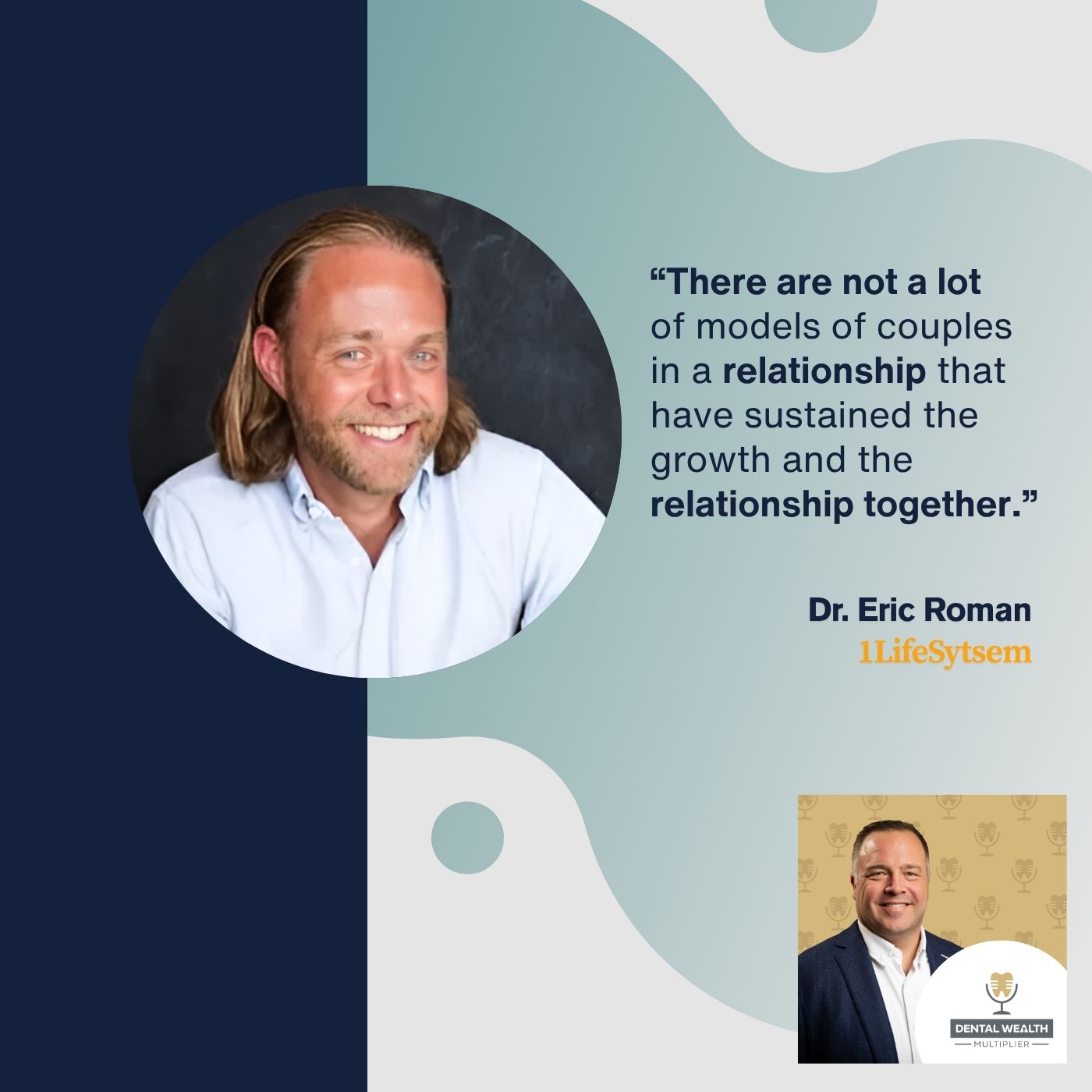
I think that you two are admirable inside of that. I remember when I was on that journey, there were a lot of stories about how that wasn’t possible, about how, if you two are working together, that’s not going to fit. That’s going to be a rate limiter. I heard people say that too. When you two talk about how you’ve been able to support yourself in the journey, I know for me, I actually have some envy. I feel some envy. I think it’s a really cool maybe side offering that readers can have inside of the industry, to just recognize that this is actually possible and it’s beautiful. I’m really encouraged by who you’ve been.
Thank you. We appreciate that. I think probably having respect for each other. Respect of not as your wife, but this is another business person and this is a serious business person. That respect probably has worked out well, just knowing that we each have strengths that we couldn’t live without. Recognizing that has been very helpful for us
Plus, I think growing. We both are very committed to growth. When problems happen, sometimes as one person can stagnate, they’re like, “I don’t want to do this.” Hopefully, we won’t ever get to that point, but we’re both very committed to personal and professional growth.
It’s why we do pretty much every single thing together. Some people ask us, “Can you not do stuff not together?” Actually, no, because that creates a little bit of a disconnect. I have to go explain to her. Why is that a good thing?
I joke around. I’m like, “He’s my emotional support animal.”
Likewise. Trust me.
Maintaining A Well-Rounded Team
You were mentioning earlier, too, that loneliness. Eric and I have talked about this as entrepreneurs, as you go through this journey, it can be lonely and how blessed are you that you have a partner who’s going through it with you, so you’re not completely alone. You might be feeling that isolation, but you do have that person who’s right there. I’d like to go back to something that you mentioned earlier which was about hiring A players and making sure that you have A players. That’s something that I think sometimes we just throw out there, “We hire A players.”
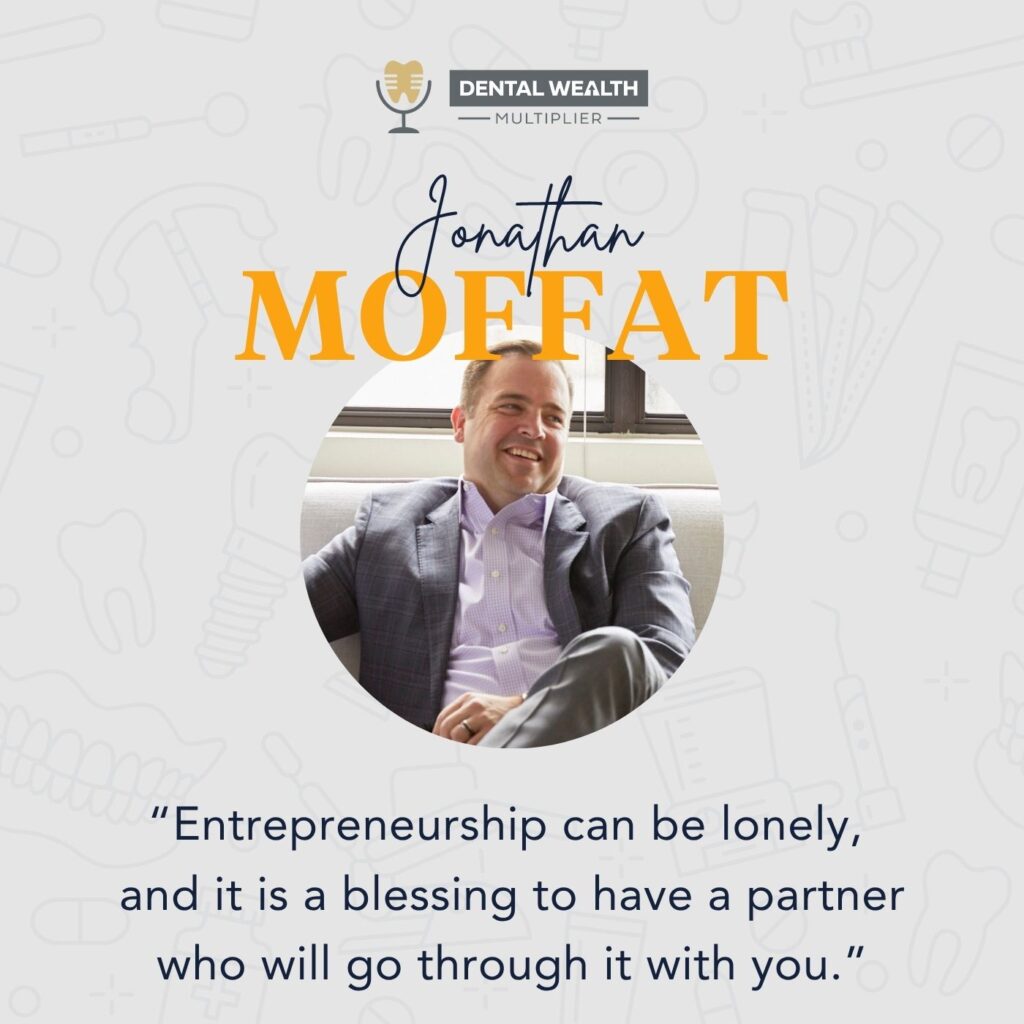
If you’re reading this, you’re like, “What does that mean?” All goes into making sure that not only we are hiring a players, but how do we then vet them to make sure that they continue to be A players and the type of team members that are going to get us to where we want to go? You talked to us a little bit about maybe that process for you of hiring or training or reevaluating those, those team members to make sure that you do have A players.
We actually have a framework that we use for A, B, and C players. We often talk about this internally with our ops team, how to hire the best people. In EOS, they call that people analyzer. You plot them against their core values and you put plus minuses, that’s one way to do it. The A, B, C quadrants with C players on the bottom left, B up top, A upright and D on the bottom. D should not exist in your business. If you plot them on a graph, which is high capability and high commitment, you start to look at who has high capability. C players generally have low of both, so then they should be fired.
B players generally tend to have high capability, but low on commitment. How do you handle someone like that? They have an ego. You have to give them credit for what they did, but then you have to challenge them. A players, all you have to do with A players is you just acknowledge that they’re an A player and ask them to help you. The B player that’s low in capability and high in commitment, you just coach them, you mentor them, you support them. That’s how we look at every single person in the business now and usually, they all fall into 1 of those 4 quadrants.
B players are usually low in capability and high in commitment. You just need to coach, mentor, and support them. Share on XObviously, we’re not without error. We’ve made mistakes, too. It’s just about how quickly we can correct those mistakes and find that A player. People talk about turnover like it’s a bad thing. There’s good turnover and there’s bad turnover.
Self-selected turnover?
Especially when it’s their idea.
Is there a framework you follow in terms of how much time you’re willing to give someone? Let’s say they’re showing high capability, but low commitment. When you’re talking to them and coaching them through that, do you have like, “We’re going to give this person X number of time and if we don’t see an improvement, we’re going to make a change,” and being proactive on that?
Yeah. The B player that does high-end commitment, but low in capability, we generally don’t tend to exit them out of the business. We want to continue to work with them to make them an A. The B player’s high capability, low commitment, our standing instruction to our ops team is we need to let them go in two weeks. We were not doing this. We were not always good at this. I think in the last six months, we’ve really held true to that. We are exiting a lot of people really fast and then really taking our time. We’re also looking at predictive index as a recruiting tool to make sure we get the right people.
I want to sit in this for a little bit longer. I’m going to tell you something I discovered that makes sense and blew my mind. I piloted a community for associates. I’ve got about 30 associates, and it’s like a bootcamp. It’s like 45 days. In asking them questions like, “What’s not the way you expected it or what’s getting in the way,” I’ve had 6 out of the 30 that have confessed, and I honestly didn’t ask everybody. There were six who said their entire team has turned over recently. In other words, they had nobody. We’ve all seen it, the explosion of turnover, and you have no one. Their frustration is that, A, it’s their problem. They’re the ones who are dealing with a bunch of green team members.
B, they have no idea what to do. They were just buying a day job. They thought somebody was going to handle all this. What would you say right now to them? I know we’re going to have people that are reading because they’re reading because they’re not doing any dentistry and they’re reading this instead because their chairs are empty. What would you say to a doctor that’s in that situation that doesn’t have the skills that might not have A players? Where do they start in their team journey?
Are we specifically talking your associates or owner doctors? I think the answer would differ.
Yeah, that’s a good point. Maybe talk about that. What would you say to an associate? What would you say to an owner?
I think if an associate is in a group where there’s constant turnover and they’re with a bunch of green people and nobody’s training those people, that may not be the right place to be in because it’s just going to completely implode. For an owner, being an owner operator is really tough, like a clinician who’s like running your own practice. We’ve noticed so many clinicians and we were guilty of that too in the beginning. You let people walk all over you just because of that fear of it’s better to have this C player than nobody. I would say probably number one is letting go of that fear. I keep going back to that.
Number two is probably going to be, I would say maybe personality tests and doing something different in your interview process to get the right people in there. I know at the single practice level, it’s a lot tougher. I’d probably say find that replacement before you let go of that person. Sometimes you have to let go of the bad apple. It’s just going to become much worse and you’ll get through it. It’ll happen.
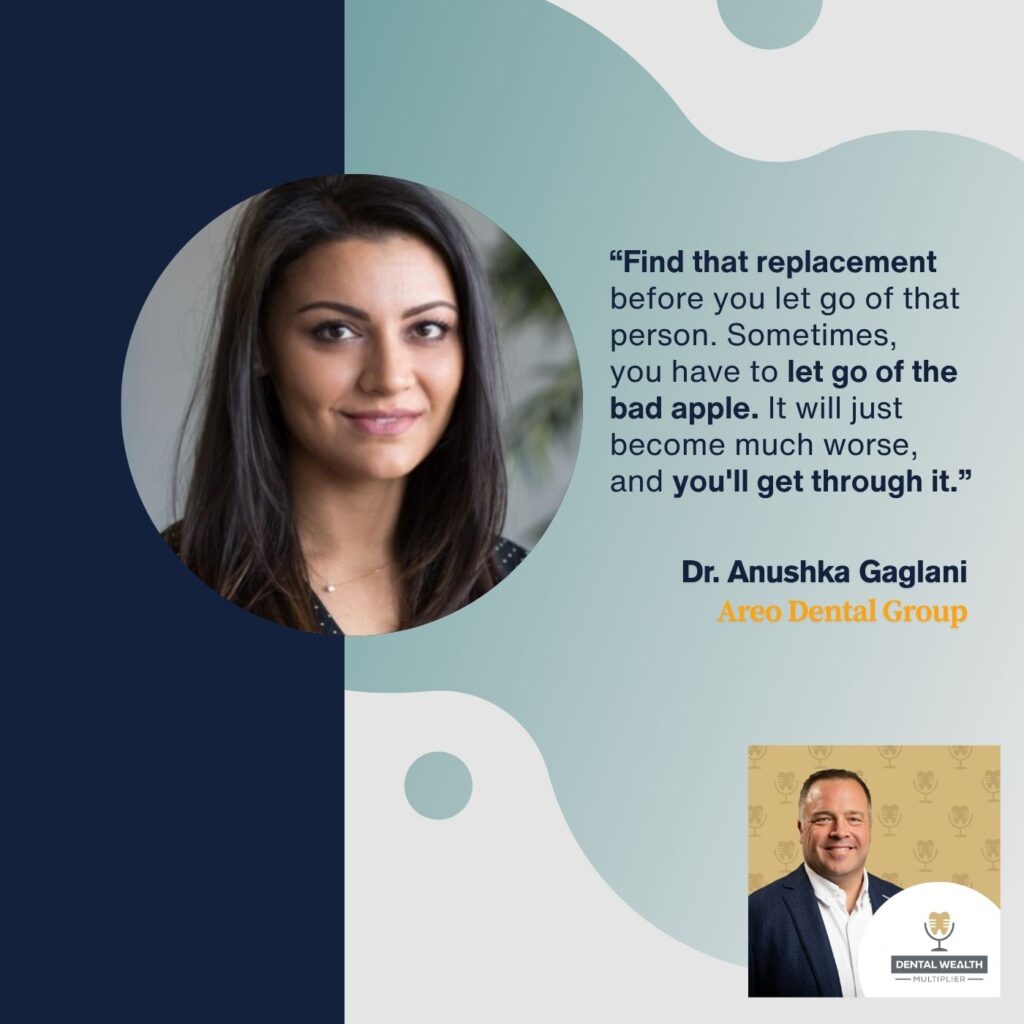
Those are really good thoughts. Maybe an additional point would be for an owner, sometimes I’m going to be in the chair five days a week even and then hang on to a bunch of C players. Cut back a day. Make sure you free up your time to actually recruit a couple of rock stars and then the tide will turn. For associates who are in a bad spot, I think I would probably ask more questions to them.
A lot of times, associates, without knowing because they haven’t been there, this is their first job, are they saying stuff to the practice that’s actually sabotaging the practice, but also self-sabotaging them? I’ve seen that. I’ve probably been guilty of that as an associate myself. I’ve said stuff like, “If you’re getting paid too little, you should go work somewhere,” but I was left with no assistant.
I actually got a ton from that, in sitting and thinking about it. What I picked up, Anushka in particular, with your response, was where are the right questions that our associates should actually be asking? We look at the percentage of our doctors in our country right now who are employed. Did they ask questions about tenure? Did they ask questions about what the leadership and management structures like in the office? Who reports to whom?
Did they ask questions about what is expected of them if and when this occurs inside of there? It’s just stuff that it might not change our decision, but the answers would be nice to know. That’s what really came up for me in inside of what you said. I’ll be like, it’s just so encouraging what you said to sit there and say, Owner, I know it sucks, but this isn’t actually the end of the world. The more that it hurts, the more that it might force you to get the skills you need and make the changes, I’m sorry it hurts, but you’ll thank me later.”
That’s how I feel looking back. The loneliness that you guys talk about, I didn’t have anybody to say that to me because shows didn’t exist, or at least I don’t listen to them. I just wish I’d had you say that to me “It’s okay, little fella. It’s going to be all right. It hurts right now. It sucks. Your revenue hurts, but let this be the energy you need to get better.” Look at how much encouragement you guys have given me.
I think along those lines, Eric, too, as they were talking, too, I think Anushka, you mentioned something about just having that courage to believe in yourself. We’ve all been to those places. I remember with our practices where we allow ourselves as owners to let some of these team members make our lives so difficult. They really have such a huge impact.
A lot of times, we don’t realize what that impact is until after that person’s gone. A lot of times, as owners, we hang on to that person because, like, “They run my whole operation or they run my whole office, or they make all these decisions.” I think it’s understanding and knowing, too, as an owner, that letting someone go is not necessarily a bad thing.
I think what happens a lot of times, what I see, is that they don’t have the framework or the systems or the process to hire the right person and then make sure that that person’s trained. You start thinking about, all of a sudden, it’s so much work and I have to train this new person. I have to get him in. It’s just easier to just deal with this person’s baloney. That’s how you end up with practices that are at 15% net income or your patients are constantly canceling and not reappointing and you have all this snowball of issues.
To be fair, at this point, we have economies of scale. We’re able to hire the support that we need to help us with this stuff. There are all kinds of technology out there like patient prison, etc., whatever. Until you have somebody to help implement it, it’s pointless to get all of those. You have to do something with that information. Again, we totally get it at the single practice level. It’s definitely a challenge, but maybe even outsourcing, getting outsourced help in the meantime rather than taking all of that.
A really good point. There’s so much good outsourced help right now. Outsource fractional CFO services to outsource billing and accounts receivable, it can all be done relatively inexpensively now, so we don’t have to try and build everything.
Even automating a lot of it. There’s so much technology now with the practice management systems where you can automate patient communication. Patient billing, patient paying, making their payments, setting their appointments, re-scheduling. A lot of it can be automated to where a lot of that, maybe in the past and maybe for some offices reading this, they haven’t made the leap into the technology space and they don’t really know what those resources are, in which case, stay tuned. We’ll talk about more of those resources.
This is just any small business. Anytime, like E-Myth, you read that book or EOS. Any of these small businesses that are dependent on 1 or 2 people, you’re always feel that pressure and that risk of that person because you’re like, “If they go, I don’t know how I’m going to survive.” It’s how can you take that power back as the owner and that control back, so that you can go hire A players and build a team that’s going to actually take you to where you want to go.
You hit the nail on the head. I think Dan Sullivan, the author of Who Not How, has been instrumental in shaping some of our thinking too. You can ask the question, “How do I accomplish this,” or you can ask the question, “Who is the person I need who can figure out the how?” Once you figure out that, once you go on that track, it’s really hard to not get the right people because the right who’s will do the very thing that we don’t like to do, and that’ll be their passion. They’ll figure out the how. It’s really cool how that happens.
Embracing Patience And Discipline
If we could leave our readers with maybe one nugget, one thing of like, “Here’s your biggest takeaway,” or “Here’s this one thing,” if I were in sitting here with a single practice and trying to figure this out or profitability, I know one of the reasons I want to jump on here was really to talk about the impressive profitability that you guys have, what would be that? What would be that thing that stands out to you or we could leave our readers with something that, like a good takeaway, a good nugget from this episode. There’s a lot of great nuggets, but if you just do this one thing, this is what I would do.
I think for me, it’s probably the toys, the nice things you want to buy for your office, it’s great. Be careful with what you’re bringing on too quickly. Also, it takes me back to a quick little story. We used to use a supply company and the rep we had was amazing. He left the company. He was replaced by a different rep who was not quite so amazing. When we were talking about supply costs, he told me, “I am a consultant, not just a supply rep, and don’t trip over dollars to pick up pennies. You should just try to increase your revenue instead.” I said, “We could do both.” Don’t listen to the salespeople. Their job is to sell.
I think my closing thought would be, I think that saying that I said earlier, revenue is vanity, profit is sanity, cash is king and queen. It’s not my quote. I can’t remember the author of that. It was in a book that I read, but it resonates every single day. I think about that every single day.
Dr. Nagaraj, you mentioned something Alex Hormozi earlier. I love it. I listen to his stuff at the gym all the time. I listened to something and he said he checked his bank balance every single day until I think he said he got to like $16 million in his bank, “All right, I can stop checking my bank balance now.”
I think there’s another quote I love. Jim Carrey, oddly enough, said it, and it was, “If you’re willing to sacrifice for 12 months, don’t buy that car you want, don’t buy that purse you want, don’t buy that watch, that house for 12 months and really batten down the hatches and get lean. If you’ll do that for twelve months, you can set yourself up for the rest of your life.”
I think the purpose of that is if we’re willing to sacrifice those things that we feel like we need, “I just went to this conference center, or I just went to this association event and my state dental association event, and they’re doing a deal on CEREC. I know my CEREC’s only two years old, but the new one looks so nice.”
A lot of times, I think we see these doctors get wrapped up in that. In our offices, we would always bootstrap stuff. We’d buy refurbished equipment if the practice couldn’t afford it. We would go in and redo just the flooring and the paint for a couple of thousand dollars, just really doing it bootstrap as opposed to going and taking a big loan and things like that. I think if you focus on the cash, the profitability, the cash, cash is king and queen, like you said, I think a lot less practices would be feeling the financial pressures that a lot of them are feeling.
You’re so right. I think I’m hearing you say delayed gratification. Practice delayed gratification. Not everything needs to be instant. Patient ambition is a good thing. Over time, we’ve had to even reinforce that to ourselves.
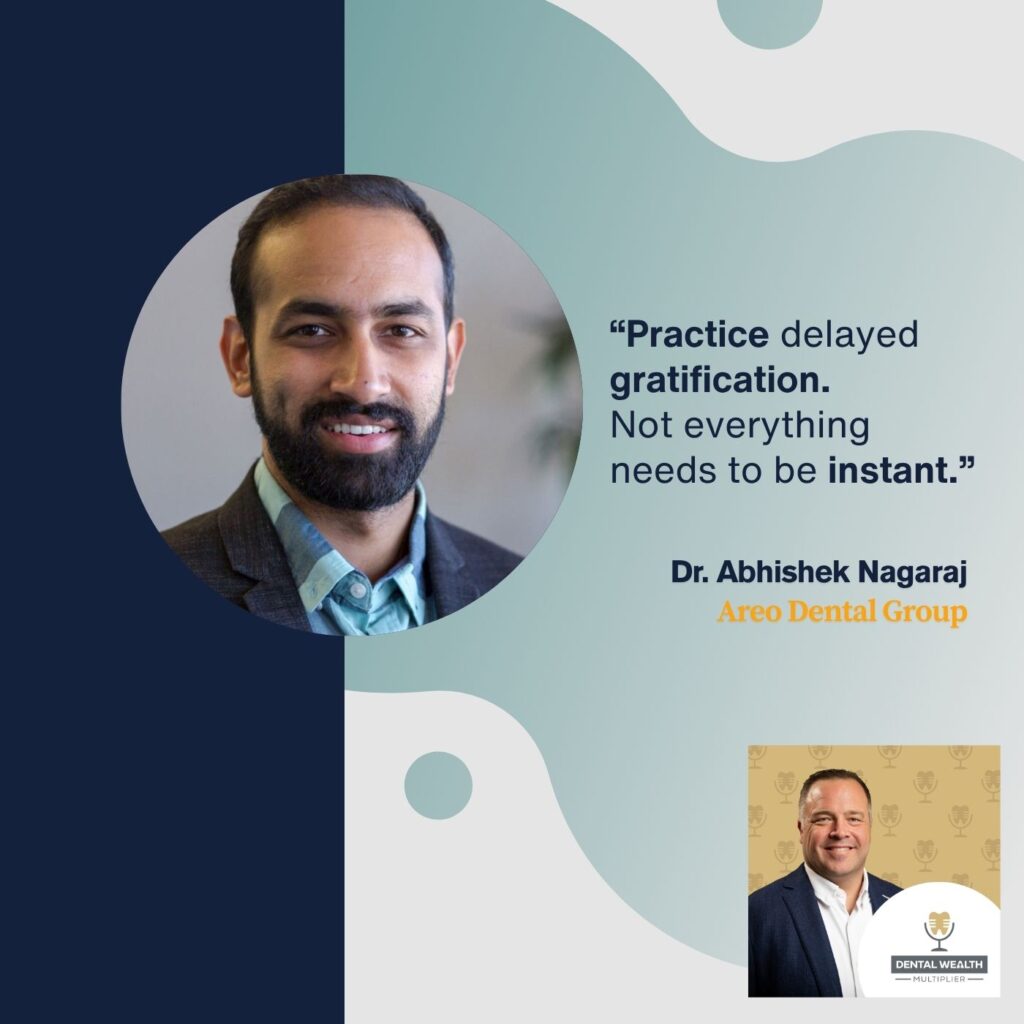
What’s that quote? You can have everything you have, just not all at once.
You can have everything you have, just not all at once. Share on XIf you have that discipline and that patience, it will come. Look what you’ve been able to build because you’ve been disciplined, you’ve stuck to this is our model, this is how we work. You have this discipline that you’ve developed in addition to the personal work that you’ve done as well to become the leaders that you are. I think all of that combined has helped contribute to your success, undoubtedly.
Thank you. We appreciate that.
Get In Touch With Drs. Anushka and Dr. Abhishek
Thank you both for being on here. I really enjoyed this. I’ve been looking forward to this conversation and this episode. I know we’re probably going to get a lot of questions. If anyone who’s reading wants to check you out, are you in the Chicago area? If you’re reading this and you have a practice in the Chicago area and you’re like, “I would love to partner with these two, or I would love to sell my practice to them or learn from them,” you can go check them out at their website, AreoDental.com. If I were in the Chicago area, I’d be hitting you guys up. You’re amazing.
Thank you.
Very impressive as well with what you’ve both been able to build and put together here. Thank you so much for coming on here and sharing your journey and your story with us. I really appreciate that.
Thank you so much for your time.
Likewise. We appreciate your time a lot, too.
Austin, thanks for joining us as well. If you have any additional information about bookkeeping or accounting or fractional CFO services, you can go to DSOCFO.com and you can check them out as well.
Highly recommended.
Thank you.
Thanks for being on here as well. Until next time, everyone has a great day.
Important Links
About Dr. Eric Roman
 Dr. Eric J. Roman started his professional journey as a dentist, but soon became the CEO of fast growing, multi-location dental groups that generated over $200m in care during his leadership. Eric strategically led his DSO through an exit in 2019, and chose to step out of DSO leadership to pursue a more balanced life.
Dr. Eric J. Roman started his professional journey as a dentist, but soon became the CEO of fast growing, multi-location dental groups that generated over $200m in care during his leadership. Eric strategically led his DSO through an exit in 2019, and chose to step out of DSO leadership to pursue a more balanced life.
His next growth phase came in the form of executive coaching and thought leadership, both inside and outside the dental industry. As one of the dental industry’s most esteemed experts on team dynamics, emerging DSO operations and associate dentist development, Eric spent several years coaching a community of more than $3B in annual revenue via the Dentist Entrepreneur Organization.
After his tenure at the DEO, Eric shifted his energy toward addressing an alarming trend: data is showing that, despite the success of our businesses, entrepreneurs and their teams are continually less fulfilled in their personal lives. To solve this, Eric developed the 1LifeSystem, a simple, recurring digital retreat that delivers personal fulfillment without sacrificing professional success. Whether it’s as a founder, operator, advisor, or investor, Eric loves to put his energy toward moving our industry forward.
About Austin Moffat
 Austin Moffat is a renowned expert in the dental accounting and fractional CFO sector, serving as the Managing Partner of DSO CFO, a specialized firm dedicated to providing comprehensive financial services to dentists, Dental Support Organizations (DSOs), and dental group practices. With a wealth of experience and a deep understanding of the financial intricacies unique to the dental industry, Austin has established himself as a pivotal figure in helping dental practices achieve sustainable growth and secure necessary funding.
Austin Moffat is a renowned expert in the dental accounting and fractional CFO sector, serving as the Managing Partner of DSO CFO, a specialized firm dedicated to providing comprehensive financial services to dentists, Dental Support Organizations (DSOs), and dental group practices. With a wealth of experience and a deep understanding of the financial intricacies unique to the dental industry, Austin has established himself as a pivotal figure in helping dental practices achieve sustainable growth and secure necessary funding.
In his role at DSO CFO, Austin leads a team of professionals who offer tailored financial solutions, ranging from bookkeeping and tax planning to strategic financial management and growth funding. His expertise extends to managing the financial complexities of multi-location dental practices and DSOs, ensuring they operate efficiently and profitably. Austin’s approach combines detailed financial analysis with strategic insights, enabling his clients to make informed decisions that drive their businesses forward.
About Dr. Abhishek Nagaraj
 A full arch implant surgeon and Entrepreneur with an obsession to create stellar patient experiences and a deep passion and commitment to empower dentists, executives and their teams to live a better life. Strong interest in scaling dental acquisitions, Denovos and growing them into multi million dollar self sustaining practices, remove obstacles to growth and improve people’s leadership skills through communication, execution and accountability.
A full arch implant surgeon and Entrepreneur with an obsession to create stellar patient experiences and a deep passion and commitment to empower dentists, executives and their teams to live a better life. Strong interest in scaling dental acquisitions, Denovos and growing them into multi million dollar self sustaining practices, remove obstacles to growth and improve people’s leadership skills through communication, execution and accountability.
About Dr. Anushka Gaglani
 Practicing dentist focused on changing dental experiences for the better one patient at a time. Passionate about empowerment of women in dentistry and growing dental practices. Co founder and co-CEO of Areo Dental Group, a multi practice Dentist Partnership Group located in Chicago, surrounding suburbs and Indiana. Practices include: TruBlu Dentistry Burbank and Hegewisch; Steger Smiles Family Dentistry; Blue Island Smiles; St John Smiles.
Practicing dentist focused on changing dental experiences for the better one patient at a time. Passionate about empowerment of women in dentistry and growing dental practices. Co founder and co-CEO of Areo Dental Group, a multi practice Dentist Partnership Group located in Chicago, surrounding suburbs and Indiana. Practices include: TruBlu Dentistry Burbank and Hegewisch; Steger Smiles Family Dentistry; Blue Island Smiles; St John Smiles.
